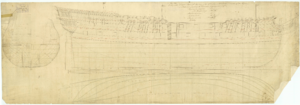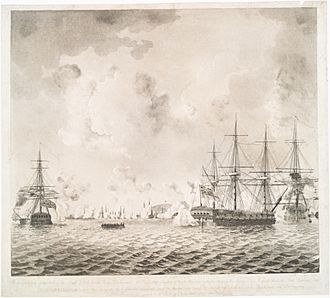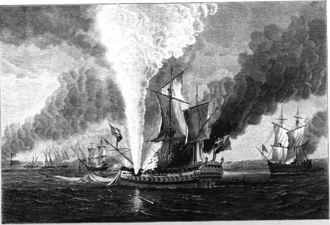HMS Augusta (1763) facts for kids

HMS Augusta
|
|
Quick facts for kids History |
|
|---|---|
| Name | HMS Augusta |
| Ordered | 13 January 1761 |
| Builder | Wells and Stanton, Rotherhithe |
| Launched | 24 October 1763 |
| Fate | Burned, 22 October 1777 |
| General characteristics | |
| Class and type | St Albans-class ship of the line |
| Tons burthen | 138133⁄94 (bm) |
| Length | 159 ft (48 m) (gundeck) |
| Beam | 44 ft 4 in (13.51 m) |
| Depth of hold | 18 ft 10 in (5.74 m) |
| Propulsion | Sails |
| Sail plan | Full-rigged ship |
| Armament |
|
HMS Augusta was a powerful 64-gun warship. It was a third rate ship of the line for the Royal Navy. The ship was built in Rotherhithe and launched on October 24, 1763.
Sadly, the Augusta was destroyed by fire. This happened on October 22, 1777, during the Battle of Red Bank. The ship had run aground in the Delaware River before the fire.
The Loss of HMS Augusta

On the evening of October 22, 1777, the Augusta and other British warships sailed up the Delaware River. They were led by Admiral Francis Reynolds. Their goal was to attack Fort Mercer the next day. They stopped just below some underwater barriers called chevaux de frise.
As the water level dropped, the Augusta got stuck on a sandbar. Another ship, HMS Merlin, also ran aground. Even though HMS Roebuck tried to pull the Augusta free, it stayed stuck.
The Battle and Fire
Around 9:00 AM on October 23, a big battle began. Other British ships, HMS Pearl and HMS Liverpool, joined the attack. They fired at Fort Mifflin. The American Pennsylvania Navy, led by Commodore John Hazelwood, also launched four fire ships. These were ships set on fire and sent to crash into enemy vessels.
At about 2:00 PM, the Augusta caught fire near its back end. An American person watching saw it happen. The fire quickly spread all over the ship. Soon, the entire warship was covered in flames. About an hour later, the fire reached the ship's magazine. This is where the gunpowder was stored. The ship exploded with a huge blast.
The explosion was so powerful it broke windows in Philadelphia. People heard it up to 30 miles (48 km) away in Trappe, Pennsylvania.
Why the Ship Exploded
People had different ideas about why the Augusta caught fire. The British said that hot wadding from their own guns set the ship's ropes on fire. Some also thought the crew might have set the fire on purpose. Americans believed a fire ship hit the Augusta. Others said hot cannonballs from Fort Mifflin caused the blaze.
John Montresor, a British officer, wrote about the sad loss. He said one lieutenant, the ship's chaplain, and 60 sailors died. They were struggling in the water after the explosion. Soon after, the crew of the Merlin also left their ship. They set it on fire, and it exploded later that day.
Legacy of the Augusta
The Augusta was the biggest British ship lost in battle by the Royal Navy. This happened during either the Revolutionary War or the War of 1812.
In the 1870s, people thought there might be gold in the ship's wreck. Parts of the ship could still be seen in the river. This led to efforts to find things from the wreck. They found tableware, a watch, coins, and three cannons.
There was an attempt to move the ship for a display. This was for the 1876 Centennial Exposition in Philadelphia. But it didn't work, and the ship got stuck again. It was near Gloucester City, New Jersey. For a few years, it became a tourist spot. People paid to see it. But then, a big storm broke the ship apart.
The Daughters of the American Revolution took much of the wood from the ship. They used it to create an English-style dining room. This room is at their headquarters in Washington, D.C.. Other pieces of the ship washed up on Gloucester City beaches. Local people collected them. One person from Paulsboro collected 14 staircase pedestals. He gave 12 to the Smithsonian Institution. He gave one to the Gill Memorial Library in Paulsboro.


